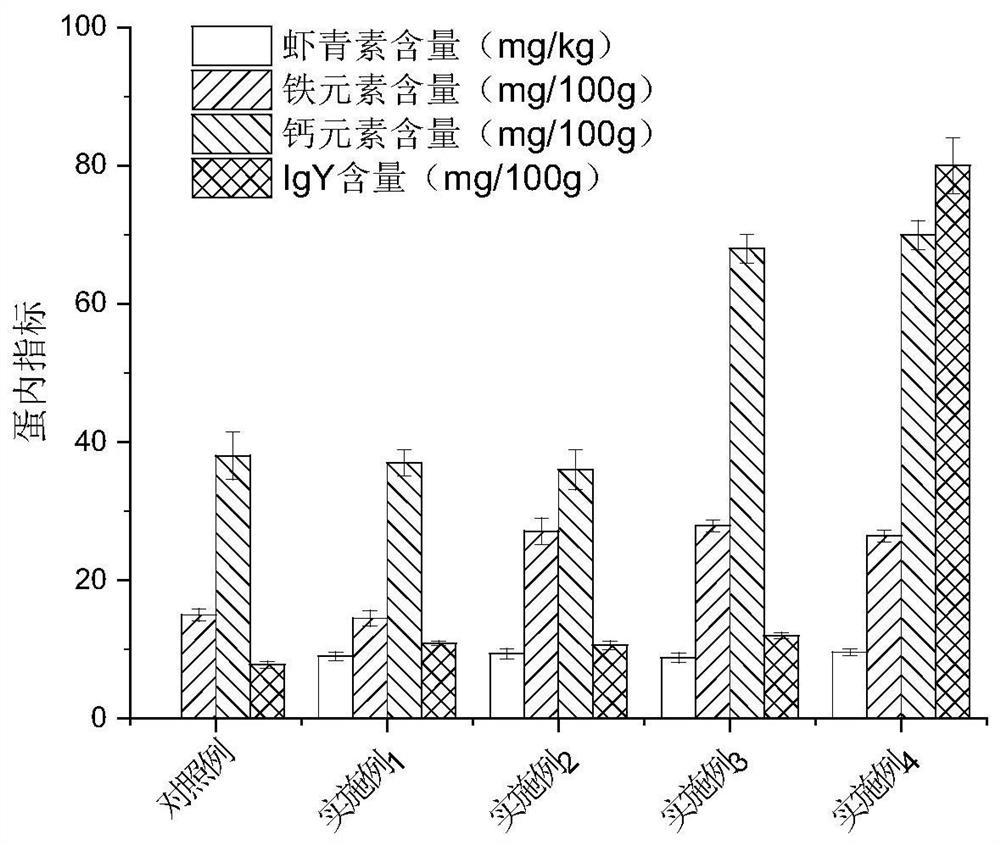Method for improving egg quality
An egg quality technology, applied in animal feed, additional food elements, animal feed, etc., can solve the problem of low conversion rate of eggs, increase the content of astaxanthin and iron and calcium, improve physical fitness and desire to eat, The effect of increasing content
- Summary
- Abstract
- Description
- Claims
- Application Information
AI Technical Summary
Problems solved by technology
Method used
Image
Examples
Embodiment 1
[0034] 1. The laying hens are fed with the basic feed added with special feed (commercially available laying hen feed+, containing 66.3% corn, 26.3% soybean meal, and 7.4% bran). 1% of the total weight of natural Haematococcus pluvialis (containing 1-5% of natural astaxanthin) is added.
[0035] 2. Feed 3 times a day, the first feeding time is 5:00-5:30 in the morning, the feeding amount accounts for 35% of the whole day's feed, and the remaining feed is evenly fed for the rest of the time; The amount of water fed to laying hens should not exceed 30 grams. The temperature of the chicken coop for laying hens is controlled at 25 degrees all year round, the stocking density is 6 per square meter, the ground illumination of the chicken coop is greater than 200LUX, and the lighting is artificially supplemented every day. The lighting time is 8-12 hours in summer and 12-12 hours in winter. 14 hours.
[0036] 3. Collect eggs daily. Carry out content determination.
Embodiment 2
[0038] 1. The laying hens are fed with the basic feed added with special feed (commercially available laying hen feed+, containing 66.3% corn, 26.3% soybean meal, and 7.4% bran). 1% of natural Haematococcus pluvialis (containing 1-5% of natural astaxanthin) and 0.1% of heme iron are added in total.
[0039] 2. Feed 3 times a day, the first feeding time is 5:00-5:30 in the morning, the feeding amount accounts for 35% of the whole day's feed, and the remaining feed is evenly fed for the rest of the time; The amount of water fed to laying hens should not exceed 30 grams. The temperature of the chicken coop for laying hens is controlled at 25 degrees all year round, the stocking density is 6 per square meter, the ground illumination of the chicken coop is greater than 200LUX, and the lighting is artificially supplemented every day. The lighting time is 8-12 hours in summer and 12-12 hours in winter. 14 hours.
[0040] 3. Collect eggs daily. Carry out content determination.
Embodiment 3
[0042] 1. The laying hens are fed with the basic feed added with special feed (commercially available laying hen feed+, containing 66.3% corn, 26.3% soybean meal, and 7.4% bran). Add 1% natural Haematococcus pluvialis (containing 1% to 5% natural astaxanthin), 0.1% heme iron, and 0.1% calcium lactate;
[0043] 2. Feed 3 times a day, the first feeding time is 5:00-5:30 in the morning, the feeding amount accounts for 35% of the whole day's feed, and the remaining feed is evenly fed for the rest of the time; The amount of water fed to laying hens should not exceed 30 grams. The temperature of the chicken coop for laying hens is controlled at 25 degrees all year round, the stocking density is 6 per square meter, the ground illumination of the chicken coop is greater than 200LUX, and the lighting is artificially supplemented every day. The lighting time is 8-12 hours in summer and 12-12 hours in winter. 14 hours.
[0044] 3. Collect eggs daily. Carry out content determination. ...
PUM
 Login to View More
Login to View More Abstract
Description
Claims
Application Information
 Login to View More
Login to View More - R&D Engineer
- R&D Manager
- IP Professional
- Industry Leading Data Capabilities
- Powerful AI technology
- Patent DNA Extraction
Browse by: Latest US Patents, China's latest patents, Technical Efficacy Thesaurus, Application Domain, Technology Topic, Popular Technical Reports.
© 2024 PatSnap. All rights reserved.Legal|Privacy policy|Modern Slavery Act Transparency Statement|Sitemap|About US| Contact US: help@patsnap.com









